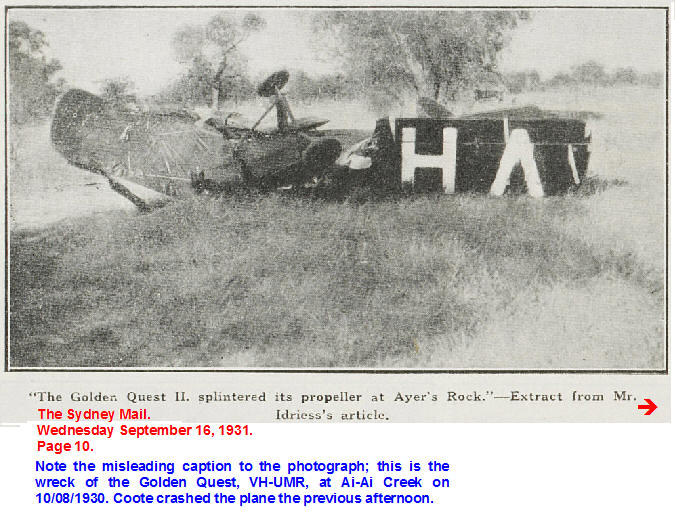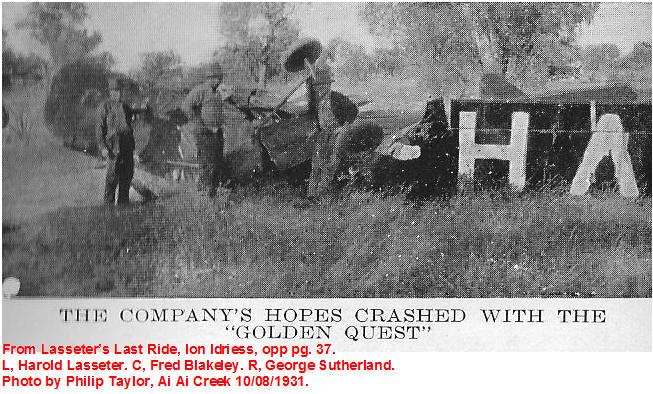| 110. GOLDEN QUEST the. VH-UMR. |
| "There lay our pretty painted Golden Quest, a crumpled heap". |
| Blakeley. Dream Millions 69. |
|
The famous Gipsy Moth, a light bi-plane aircraft constructed by the De Havilland Aircraft Company at Edgeware, Great Britain. One of De Havilland's most successful designs, over 3000 of these sturdy and versatile aircraft were built worldwide and a few are still flying today. The air worthiness certificate, number 1806 for this plane, was issued by the British Air Ministry on 20/09/29. VH-UMR is a plane with history, first purchased by the Queensland and Northern Territory Ariel Services Limited of Longreach, Queensland in May 1929. The plane was onsold and shipped to De Havilland's Melbourne office, where coincidentally it was reassembled and certified airworthy by Philip Lawrence Taylor on 1/11/29, in preparation for resale to Alec Barlow who took delivery of his near new metal Gypsy Moth, type 60M, on the following Monday. Barlow had written off his first aircraft in a 'lucky' crash a fortnight earlier and VH-UMR was given a good workout over the next seven months as Barlow honed his flying skills before moving on to positions of influence in the aviation industry. By all accounts Barlow and his 'Sky Hawk' got on well. Barlow sold the aircraft to Kenneth Wedgwood on 22/6/30 and the change of ownership was officially acknowledged a few days later. The new owner immediately let it be known that the plane was for sale and Charles Ulm engineered a deal on behalf of C.A.G.E. in early July 1930. Ernest Bailey immediately notified the Civil Aviation authorities of the second change of ownership and there's a sense that VH-UMR fortunes changed from this day on. A keen eyed bureaucrat noticed that all was not in order with the registration and ownership of the plane and wrote separately to Wedgwood and Bailey on 10/07/30, requesting an explanation from both parties as to who owned the aircraft and until he was satisfied VH-UMR was effectively unregistered and therefore grounded. Meanwhile Ulm had test flown the plane and pronounced it easy to handle and with a good turn of speed, ideal for the job ahead. Over the next week preparations were made for the flight to Central Australia, including a repaint with black fuselage and red wings and the name 'Golden Quest' added to the engine covers. Perhaps Ernest Bailey and Coote were unaware of officialdoms temporary veto on flying the aircraft when they set off for Morree on 12/7/30, but the Company Secretary could hardly ignore the stern letter waiting for his return a few days later. Bailey added to the developing bureaucratic tangle by handing the problem to De Havilland's new Sydney office, as agents in the sale he considered it their problem to sort out the registration and ownership of the aircraft. Bedford, the Company secretary for De Havilland's finally sent the appropriate paperwork to Civil Aviation on 18/7/30, the day before Coote and the Golden Quest left for Alice Springs. It is possible that Coote chose to ignore the implications of flying an unregistered aircraft when he took off from Mascot airport next morning. The rest of the expedition was well underway by rail and time was pressing, the brash Coote would take his chances and claim innocence in the unlikely event of apprehension, after all he was only the pilot. He would have been quite unsettled at the content of the letter from Civil Aviation that crossed Ern Bailey's desk on the 3rd of August. DeHavilland's letter of the 18th had not clarified the ownership issue and the aircraft remained to be registered. This time the authorities were adamant and warned Bailey, "that any flights carried out in the aircraft pending re-registration will constitute a breach of the Air Navigation Regulations which is seriously regarded by this branch and regarding which the Department will take action against those so offending". Ernest Bailey, now thoroughly irritated and convinced that Charles Ulm was in some way involved in the debacle sent the registration forms and an explanatory letter to Civil Aviation the next day. The matter was finally cleared up to Civil Aviation's satisfaction and VH-UMR was registered for a year from 8/7/30. Next day Coote crashed the plane at Ai Ai Creek. Coote had a very lucky escape, the plane was so seriously damaged that only the fuselage aft of the front cockpit and the undercarriage remained intact. Colson rushed Coote to Alice Springs for medical attention, leaving the wreckage upside down and on it's nose, to be found by the search party from Illbilla a few days later. Under Taylor's supervision the plane was dismantled, ready for loading onto Colson's truck on his return to Ai Ai Creek. Coote later noted that axes had been used to remove the wings thus turning a salvageable plane into a write off. After a difficult return to Alice Springs Colson left the wreckage at the Police Station on 17/8/30 where it remained for several weeks until Blakeley arranged for it's shipment to Adelaide, where Horrie Miller from the Commercial Aviation Company would assess the damage and consider rebuilding the plane.
In mid April 1931, after some badgering from the authorities, Ern Bailey informed Civil Aviation that the wreck of the Golden Quest had been sold in it's crashed condition to Miller, apparently for 153 pounds fifteen shillings and the engine for a tenner. The forlorn wreck of VH-UMR remained in Miller's hangar at Parafield for many months, finally being rebuilt and test flown by Miller on the last day of August 1932 and made ready for sale to Mr. K. Gardiner who received the certificate of registration for VH-UMR valid from the 6th of September 1932. The game little plane was in the air again and despite some arguments over ownership, served the Gardiner family well, until sold to Auckland Aero Club in August 1934. Three months later the plane had a mid air collision with a Desoutter aircraft over Waihou in New Zealand, the pilot, C.C. Waite was killed and VH-UMR was destroyed. Somehow this much travelled and abused plane deserved better.
© R.Ross. 1999-2006 |

